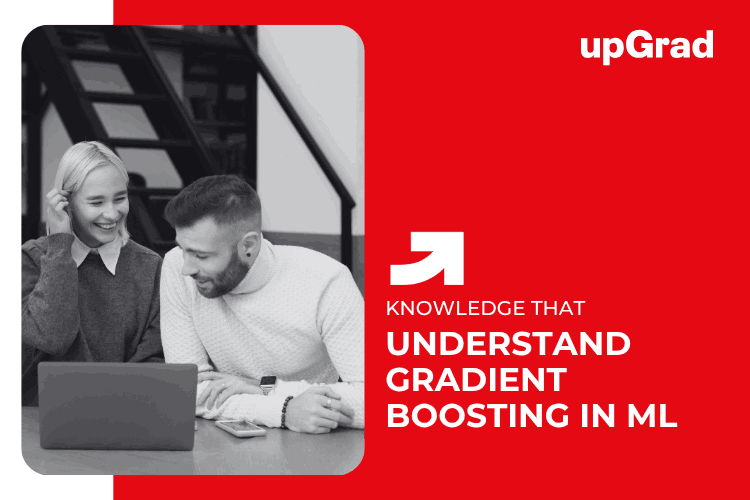The global demand for skilled AI and machine learning professionals is soaring unprecedentedly. Reports estimate that 97 million new AI/ML-linked job roles could emerge by 2025, with a 31.4% growth in employment by 2030. A large chunk of this growth will result from growing ML adoption in finance, manufacturing, and healthcare, among other industries.
If you wish to upgrade your skills in this exciting field, knowing more about gradient boosting in machine learning is crucial. It is a powerful technique that combines decision trees or multiple weak models to build a robust predictive model. Used for both classification and regression tasks, it is known for its high accuracy levels and capabilities of tackling complex data relationships. Data and AI/ML professionals should master this technique owing to its increasing prevalence across multiple business sectors.
Also Read: How to Learn Machine Learning Online in the US
Understanding Gradient Boosting in Machine Learning – How it Works?
The whole concept of boosting in machine learning involves combining multiple predictions of weak learners to build a more accurate single learner. It is far from traditional models that learn independently from the data. Here is a look at how it works:
Sequential Learning Process
A sequential learning process builds a strong predictive model through iterative training. Each model is trained after the previous one.
Error Correction
One good boosting example in machine learning is how each model corrects the errors made by the lineup of earlier models. This process is iterative until a stopping criterion is met.
Gradient Descent Optimization
Gradient descent is an optimization algorithm that iteratively adjusts model parameters to minimize the loss function (e.g., mean squared error in regression). Moving toward the negative gradient reduces residual errors between actual and predicted values with each iteration.
Final Prediction
The final prediction is made by combining all the projections made by the previous models in the ensemble. This may be done using techniques like summing up the predictions or weighted averaging.
Common Applications of Gradient Boosting
Some real-world applications of gradient boosting in machine learning include the following:
|
Industry |
Applications |
| Retail and E-Commerce |
|
| Finance and Insurance |
|
| Healthcare and Medicine |
|
| Search and Online Advertising |
|
Also Read: Difference Between Supervised and Unsupervised Learning
Advance Your Machine Learning Skills with upGrad
If you wish to build a lucrative future career as a machine learning engineer, check out the wide range of courses available at upGrad. Here are some of the advantages of choosing these programs:
- Advanced programs catering to varying levels of proficiency and differing career goals.
- Multiple choices- training & certification, undergraduate programs, postgraduate programs.
- Focus on specialized concepts like neural networks, deep learning, data science, and natural language processing while building skills in techniques like gradient boosting.
- Hands-on learning with a practical approach, live sessions, projects, and video lectures.
- Designed in collaboration with leading industry experts and universities.
Also Read: Top Machine Learning Tools Used by US Tech Companies
Explore these trending Machine Learning and AI Courses through upGrad!
- Post Graduate Certificate in Generative AI (E-Learning)
- Master of Science in Machine Learning & AI
- Executive Certificate in Generative AI for Leaders (E-Learning)
- Executive Diploma in Machine Learning and AI with IIIT-B
For more information, email globaladmissions@upgrad.com or call +1 (240) 719- 6120.
FAQs on What is Gradient Boosting in ML
Q: What is the principle of gradient boosting?
Ans: Gradient boosting combines multiple weak models to build a robust predictive model. Thus, it fuses several predictions to create a single, accurate prediction.
Q: What are the benefits of gradient boosting?
Ans: Gradient boosting ensures higher accuracy and better performance in machine learning predictions. It also helps tackle mixed data types and effectively captures complex data patterns.
Q: What is the difference between Gradient Boosting and AdaBoost?
Ans: The main difference between the concepts is how they update weak learners. AdaBoost concentrates on re-weighting training examples, while gradient boosting minimizes the loss function by fitting new learners to the residuals of the previous ones.
Q: How does Gradient Boosting prevent overfitting?
Ans: Gradient boosting uses multiple techniques to combat overfitting (models learning the training data extensively and failing to generalize to unseen and new information). Some include early stopping, regularization, and adjusting the number of trees and learning rate.
Q: Can Gradient Boosting be used for both regression and classification?
Ans: Yes, it is possible to use Gradient Boosting for both classification (the final prediction is the class with the majority of votes from weak learners) and regression (the final prediction is usually the average of all the weak learner predictions).









